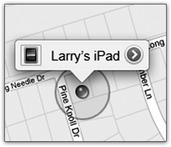Chapter 23. Discovery of Global Positioning System Evidence
Information in this chapter:
• GPS tracking evidence overview
• Discovery of GPS evidence
Evidence in cases involving Global Positioning Systems (GPS) can be a vital factor. Gathering that evidence can be a challenge as the data or evidence being sought can reside in several places: on physical devices, at third-party service providers, or as backups or data downloads. In this chapter we will look at where the data might be found and the motion language to use to make sure you get all of the evidence for analysis by your GPS expert.
Keywords
GPS, Global Positioning System, Evidence, Motions, Discovery
Introduction
Evidence in cases involving Global Positioning Systems (GPS) can be a vital factor in determining whether someone was in a particular place at a particular time, with the caveat that the information is coming from a device, not a person. Gathering GPS evidence can be a challenge as the data or evidence being sought can reside in several places: on physical devices, at third-party service providers, or as backups or data downloads on computers and smart phones.
When you begin to consider where GPS evidence may reside, the possibilities are on the GPS device itself, as a backup for data download on a computer, in place on a smart phone or pad computer, or as records collected by a third-party monitoring service.
The best-case scenario is to get the evidence from all applicable and available locations. In other words, if the only source is the GPS device itself, getting the device into custody for data collection and analysis is the only thing you can do.
However, if the device is part of a larger system, such as a monitoring system for house arrest, a monitoring system used to collect data in an investigation, or part of a system that is monitored by a third-party service, then getting the device and getting the records are equally important. How GPS works and the types of evidence that can be collected are covered in Chapter 42.
23.1. GPS tracking evidence overview
The first thing to understand about GPS tracking as evidence is the wide variety of uses for GPS tracking today. As GPS devices have become available in smaller and more varied packages, they have been adapted to more uses in everyday life. They are no longer only used by private investigators and trucking companies to track vehicles or law enforcement to track persons on house arrest. The following section provides some examples of how GPS tracking is used.
23.1.1. Categories of potential GPS tracking evidence
• Children and Teens
• GPS devices in small packages are available for clipping to a child or teen’s clothing for tracking of their whereabouts.
• School buses in many localities are also being equipped with GPS tracking.
• Pets and Livestock
• Devices are available that allow the owner to clip a GPS tracking device to a pet’s collar or to a prize bull.
• Vehicles
• Probably one of the most frequently used forms of fleet tracking. GPS devices in trucks and delivery vehicles allow the company to pinpoint the location of all the vehicles in their fleet.
• Employees
• GPS tracking on service vehicles allows companies to determine where a service truck is for routing purposes from one call to the next and also to determine the whereabouts of employees who are on the job.
• Shipments and Packages
• Small devices attached to packages and shipping containers can allow these items to be tracked worldwide.
• Persons (Electronic Monitoring)
• Ankle bracelets are used in many jurisdictions as a form of house arrest, allowing police or the court to monitor the whereabouts of persons under supervision.
• Cell Phone Tracking
• A number of applications are available for free on the Internet today that will allow tracking of a cell phone in near real time. They require that an application be installed on the phone. However, once the application is installed on the phone, the user can go to the service’s website and turn on location services to track the phone on a map. One of these services is Mobile Defense, www.mobiledefense.com.
• Computer and Pad Tracking
• Computers, especially pad computers, can be tracked via GPS in case the computer is lost or stolen. For instance, the iPad can be located using the Mobile Me service (www.mobileme.com) in conjunction with the iPad’s onboard location awareness feature. Figure 23.1 shows this location method in action.
23.2. Discovery of GPS evidence
Depending on where the evidence is located, on a GPS device, on a computer or smart phone, or at a third party, the approach to writing the technical language for inclusion in discovery motions varies. In the following sections, language examples are provided for getting evidence from devices and from third parties. In every case, as much information as possible about the device, records, or evidence needs to be requested in order to get a complete picture of the validity of the evidence. Also, when gathering devices for direct collection, requesting all of the pieces is important to avoid having to locate something as simple as a power supply that may prevent the device from being examined until a new power supply can be sourced.
23.2.1. Language for getting a GPS device for examination
A GPS device should be treated like any electronic device from a discovery standpoint. The important issues to address in a motion are in the language examples shown in the following box.
1. The device shall be made available for physical inspection and data extraction by a qualified forensic expert using tools specifically for the purpose of collecting and preserving GPS data.
2. Any reports or other information related to the chain of custody for the device, its storage and handling.
3. If the device was previously examined, any reports related to the examination shall be provided, including the methods used for the data collection, the name and version of any software used for the data collection, and a copy of the actual data files collected. Additionally, the resume or CV of the person or persons responsible for the handling, preservation, and forensic imaging and analysis of the device shall be provided.
4. Any photographs or screenshots made before, during, or after the collection of the device and its internal data.
5. Any manuals, accessories, or other items obtained and in custody related to the device, including but not limited to connection cables, power supplies, cases, carry bags, data disks, and media cards.
23.2.2. Language for getting information from a manufacturer about a device
If there are questions about the way a device functions, then the only real source is going to be the manufacturer of the device itself. The following language addresses getting device-specific information from a manufacturer.
1. This is a request for specific information about a GPS device manufactured by your company, specifically the device identified as Make, Model Number, Series Name, Serial Number, and Software Version.
2. Requested information to include specific details about the method of storage of data on the device, including but not limited to:
a. How internal data is saved to the device
b. How track logs are named
c. What happens when new tracks are added to the device
d. Whether or not date and time information is stored for track points, and when and if date and time information for individual track points is maintained or deleted
e. How waypoints are handled when the user saves a waypoint using the menu for the current location and whether or not the waypoint receives an automatic time stamp
f. How often track points are recorded in seconds
g. How many track points are allowed in a track log before automatic rollover or creation of a new track log
h. The maximum number of track points the device is capable of storing
3. Requested information to include hardware-specific information about the device, specifically but not limited to:
a. The number of antennas in the device
b. The power and signal ratings of the antennas on the device and the effect of same on the ability of the device to receive signals in normal conditions, overcast conditions, and in urban and rural settings
c. The specified range of the device for receiving satellite signals for the purpose of geolocation, in meters or miles
d. Any information regarding the ability of the device to receive assisted location services (ALS), including the type of ALS services, the accuracy enhancement of such services, and the conditions under which such services would be used by the device to assist in pinpointing its location
e. Information about the specified engineered accuracy of the device as configured, including its specified accuracy rating for geolocation
f. Any known conditions inherent to the device that can cause the device to incorrectly record its current location
g. The method used to calculate velocity and direction
h. Whether or not the unit has an internal compass
4. Information related to any known maintenance issues, failure rates, or software bugs in the device as specified herein.
23.2.3. Language for getting GPS evidence from a third party
Depending on the situation, evidence may also need to be collected from a third party, such as a monitoring service. The following language addresses the issues of importance in acquiring third-party GPS records.
1. Any and all records related to the GPS records identified by serial number(s) ________ specifically for the period of time beginning on _______ and ending on __________.
2. All information related to GPS units identified by serial number(s) ______________, to include but not limited to GPS activity such as powering up, powering down, distance traveled, mileage, latitude and longitude, location by address, speed of travel, distance traveled, long stop, short stop, and so forth.
3. Any information that is available regarding the physical GPS units that are the source of these records, identified by GPS unit serial number(s) __________. This is to include, but is not limited to: user manuals, installation manuals, owner manuals, manufacturer, make, model, dates units went into service, dates units went out of service, known issues or problems with the specific GPS models such as loss of signal, problems with calibration, pinging, areas of service, problems due to extraneous factors such as weather, and so forth.
4. Any information that is available regarding the software used by both (monitoring company) and their clients. This is to include, but is not limited to: user manuals, installation manuals, owner manuals, online documentation, known problems with the software used by either (monitoring company) or their clients, user errors that could have an effect on GPS records, and so forth.
5. Any and all maintenance records for the GPS units identified by serial number(s) ________________.
6. A list of all GPS units supported by MONITORING COMPANY NAME’S tracking system up to MONTH of 20XX.
7. Any and all information on the GPS units regarding their installation and operation. This information is to include, but is not limited to: how and where they are installed, possible errors in installation that could have an effect on GPS records, how the tracking ability of GPS units could be manipulated by being turned on and off by the user, otherwise disabling of the GPS unit, the use of software or hardware that could modify the unit, and other ways of intentionally causing a GPS unit to function in any way other than intended.
Summary
In this chapter we looked at the various types of GPS tracking evidence. We also looked at discovery language that can be used to obtain evidentiary information from third-party monitoring services and device manufacturers. Discovery language for getting the devices for examination was also provided.
..................Content has been hidden....................
You can't read the all page of ebook, please click here login for view all page.

